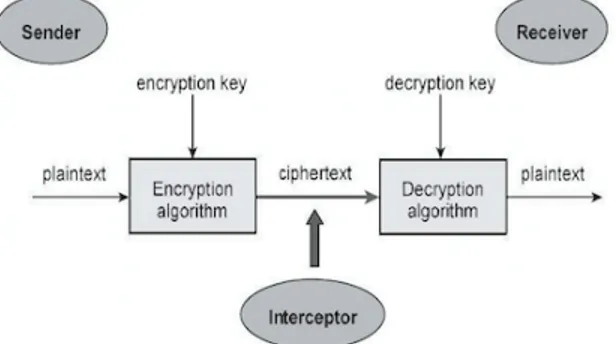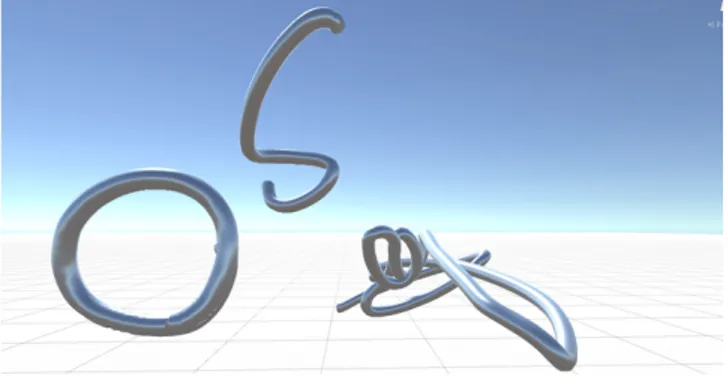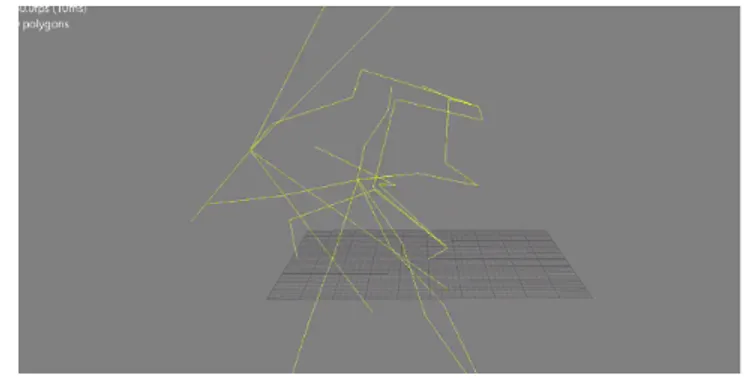The Bronze Key:
Performing Data Encryption
Abstract
The Bronze Key art installation is the result of
performative re-materializations of bodily data. This collaborative experiment in data encryption expands research into practices of archiving and critical discourses around open data. It integrates bodily movement, motion capture and Virtual Reality (VR) with a critical awareness of data trails and data protection. A symmetric cryptosystem was enacted producing a post-digital cipher system, along with archival artefacts of the encryption process. Material components for inclusion in the TEI Arts Track include: an audio file of text to speech of the raw motion capture data from the original movement sequence on cassette tape (The Plaintext), a 3D printed bronze shape produced from a motion captured gesture (The
Encryption Key), and a printed book containing the
scrambled motion capture data (The Ciphertext).
Author Keywords
Materiality, performativity, embodied interaction, encryption, motion capture, data
ACM Classification
Human Centered Computing - Interaction design theory, concepts and paradigms, - Virtual Reality; Security & Privacy - Cryptography
Introduction
The Bronze Key is the result of a collaboration between
designers and artists within the rubric of a major Permission to make digital or hard copies of part or all of this work for
personal or classroom use is granted without fee provided that copies are not made or distributed for profit or commercial advantage and that copies bear this notice and the full citation on the first page. Copyrights for third-party components of this work must be honored. For all other uses, contact the Owner/Author.
TEI '18, March 18–21, 2018, Stockholm, Sweden © 2018 Copyright is held by the owner/author(s). ACM ISBN 978-1-4503-5568-1/18/03. https://doi.org/10.1145/3173225.3173306 Susan Kozel Malmö University 205 06 Malmö, Sweden susan.kozel@mah.se Ruth Gibson Gibson/Martelli, and Coventry University Coventry, UK ruth@gibsonmartelli.com Bruno Martelli Gibson/Martelli London, UK www.gibsonmartelli.com bruno@gibsonmartelli.com
research project at Malmö University (Sweden) called Living Archives.1 It points to one of the most urgent
issues around archiving in the contemporary climate: we archive but we are archived. If we realize that our data – in particular our bodily data – are archived often without our awareness or consent, then encryption becomes a necessity that filters down to everyday usage. Jacob Appelbaum provides a succinct description of the cultural context. (See sidebar quote).
General attitudes towards encryption are that it is complex, mathematical or only used to mask illegal activities. An aesthetic approach to encryption explores the potential for new performances of encryption, removing it from the domain of the paranoid, criminal or hacker elite [13]. Obfuscation practices can be performative, playful and daily, as simple as switching off a device [4]. The design materials for The Bronze
Key experiment are: movement sequences revealing an
affective bodily state; the digital data they produce; motion capture (Perception Neuron system); VR (Oculus Rift’s Quill); animation software for visualisation (Motion Builder) and various material extractions from the encryption process. The
installation for TEI’s Art Track will focus on three non-digital artifacts (audio, bronze, print) embodying the combination of digital and physical practices that produced them. As this is an on-going research process the objects will be produced in early 2018.2
1 http://livingarchives.mah.se/
2 http://gibsonmartelli.com/SpacePlace/2017/10/12/performing-2
http://gibsonmartelli.com/SpacePlace/2017/10/12/performing-encryption/
The goal is for performative material translations to foster an awareness of the need for encryption and to spark a range of ideas around what shape encryption might take: whether or not these processes are functional is less pressing than generate ideas for how control over bodily data traces.
The Design Context: Embodied, Somatic and
Political
The Bronze Key is located at the junction where
Embodied Interaction opens onto an interdisciplinary domain, taking in politics, performance, data security and legal issues around media privacy [2], [4], [6], [8]. The work is post-digital by playing across the ways human physical interactions are digitally captured and then re-materialized once again in the physical world. This process of material translations reveal how digital materials and digital culture are not peeled away, like the unwanted skin of an orange, but remain within the newly designed object.
A somatic dimension is implied, because gestures and bodily motion cannot be disconnected from deeper affective and somatic states. Practices of somatic attention (in other words inner-sensing) that subsequently radiate into designed prototypes and design thinking are increasingly influential in the interaction design community [9], [16], as are
performative approaches to engagement with designed systems [5], [11]. However, this project adopts an approach to somatics (and by extension somaesthetics) that expands outwards from these respected
perspectives in the design community, in an attempt both to capture a frightening aspect of the human condition in digital culture and to operate with a definition of performativity that is based on
Jacob Applebaum
“Over the last forty years, a revolution has swept the planet. It happened quietly and those who noticed were ridiculed at best. It is a revolution where nearly all of our data is devoured in an automated fashion – machine to machine, person to person, voice, text. Communications, movements, all of life is consumed, quantified, searched, and catalogued.” [Applebaum 2016, 55]
transformation [7] and emergence [12]. The feeling of surveillance, and powerlessness in the face of it, produces strong affective and emotional states. Laura Poitras is the film maker who worked with Edward Snowden in 2013 to release the NSA documents revealing the extent to which the personal daily communications of citizens of the US and UK are intercepted, analyzed, recorded, and archived without consent. She kept a journal from that time. In it she combines strategies for data and personal security with poignant phenomenological descriptions of her somatic state. (See sidebar quote.)
Two design takeaways emerge: 1) that the
embodied/somatic/affective is rarely far removed from the digital in our culture of pervasive computing, and 2) given that our data is manipulated constantly, all of us very soon will have to decide what data we carry with us and whether to find our own ways to encrypt. Or as danah boyd says: “we need to reconsider what security looks like in a data driven world.” [3]
Developing new encryption practices can begin with aesthetic, metaphoric and digital experimentation.
Cryptography
Cryptography refers quite broadly to the history and science of keeping information or communication secret. Encryption is a stage within this process, made up of a set of practices that render confidential communication unintelligible, or intelligible only to those with whom we desire to communicate [14]. This standard definition of encryption can be refined for performance and affective exchanges. The performance of encryption is not based on creating impermeable barriers or permanent containment, rather it
emphasizes a re-patterning or a distortion of a flow of communication. Ambiguity and translation of bodily movement into other material forms are foregrounded, making translation and interpretation essential to the process [12], [13].
Figure 1: Basic cipher system (Piper & Murphy 2002, 8) A basic symmetrical cipher system (Figure 1) has the following stages: A plaintext (readable message) is encrypted by means of an encryption algorithm embedded in a key. This is used to translate the plaintext into an incomprehensible ciphertext (or
cryptogram). The ciphertext is decrypted by a recipient
who already possesses, or is able to guess, the key. After decryption, the plaintext is revealed once more. Classic encryption systems are symmetrical, meaning the sender and the receiver know each other and use the same key. They are also dynamic, meaning the passage of material information through time and space is usually implied. In a symmetric system the
encryption and decryption algorithms are the same. It is worth noting that the contemporary encryption system securing all confidential internet transactions – such as banking -- is asymmetrical [14].
Laura Poitras:
“The sound of blood moving in my brain wouldn’t stop. I need to decide what to carry today. Very strange – I’m less worried about crossing borders in Europe than in the U.S. But still I need to consider the danger of taking a computer. This is all total madness – this level of feeling watched And feeling I could be causing harm to others.” [Poitras 2016, 94]
The Bronze Key
For The Bronze Key experiment we performed the basic cipher system and produced various
materializations of each stage. The proposal for the Arts Track exhibition will consist in materializations of the first 3 steps: The Plaintext, The Key, and The
Ciphertext.
Figure 2: The Plaintext mocap data in .htr format
Figure 3: The Plaintext in mocap animation. For video
see https://vimeo.com/238730550
The Plaintext was a full body movement sequence (30
seconds) capturing a general state of being of one person as a message to be sent to another person. It was captured by the Perception Neuron motion capture system producing approximately 57,000 lines of numerical data representing the spatial and rotational information of each limb. (See Figures 2 & 3).
Materialization: text to speech of the numerical data recorded on magnetic audio tape and played on a cassette player.
Figure 6: Three sample keys in VR using Quill, 3D
package for the Oculus Rift in 3D .fbx file format
The Key was an arm and hand gesture (1 second)
intended to unlock the movement sequence (Figures 4 & 5). It was captured using the Quill program in Oculus Rift (Figure 6). Materialization: the 3D path of the
gesture captured in VR space (looking like a squiggle) and cast as a bronze object.
The Encryption Algorithm was a mathematical process
whereby the mocap data was scrambled by applying the data from the key: each line of movement data was
Figure 4: Key capture
using Oculus Rift
Figure 5: Key capture
subject to modification by a rolling series of
mathematical functions (basic addition and subtraction) of the data from the key.
Figure 7: The Ciphertext in mocap animation. For
video see https://vimeo.com/238730451
Figure 8: Alternate Ciphertext, on multiple bodies in
Motion Builder
The Ciphertext or Cryptogram was the scrambled
mocap data. When fed into an animation program such as Motion Builder the movement it generated was an obfuscation of the original sequence, making the affective and movement qualities unintelligible (Figures 7 & 8). Materialization: a book containing the raw
scrambled numerical data.
Decryption, or “guessing the key,” was a sort of game
by which the recipient of the message wore the Oculus Rift running neural network gesture recognition software. By repeatedly attempting to perform the gesture represented by the bronze shape of The Key, the recipient would eventually hit the right gesture that the originator of the message provided. Once the gesture was recognized the scrambled data could – in theory – be decrypted and returned to plain text of coherent motion data, fed into Motion Builder again to produce an animation of the original sequence.
performative re-materializations of bodily data pointing to a complex or layered notion of the post-digital. The premise is that bodily gestures and motions are fundamentally personal and act as identifiers in the wider domain of data analytics and forensic data analysis. Retaining power over whether to be seen or not is important. It is a design issue of increasing importance.
Acknowledgements
Thanks to Christian Skovbjerg Jensen of the Inter Arts Centre in Malmö (Sweden), the Swedish National Research Council for support of the Living Archives Research Project at Malmö University, and the AHRC funded Error Network (UK) for early research.
References
1. Jacob Applebaum. 2016. Letter to a Young Selector. In Astro Noise, Laura Poitras, (Ed.). Whitney Museum of America, New York, distributed by Yale University Press, New Haven and London, 154-159
2. Rocco Bellanova. 2014. Data protection, with love. In International Political Sociology, 8:1, 112–15. 3. danah boyd. 2017. Your data is being manipulated.
Retrieved 31 October 2017 from
https://points.datasociety.net/your-data-is-being-manipulated-a7e31a83577b
4. Finn Brunton and Helen Nissenbaum. 2016. Obfuscation: A User’s Guide for Privacy and Protest. The MIT Press, Cambridge MA and London. 5. Peter Dalsgaard and Lone Koefoed Hansen. 2008.
Performing perception—staging aesthetics of interaction. ACM Trans. Comput.-Hum. Interact. 15, 3, Article 13 (December 2008), 33 pages. DOI=http://dx.doi.org/10.1145/1453152.1453156 6. Marieke de Goede. 2017. Chain of Security. In
Review of International Studies, 1-19. doi:10.1017/S0260210517000353
8. Matthew Fuller and Andrew Goffey. 2012. Evil Media. The MIT Press, Cambridge MA.
9. Kristina Höök, Anna Ståhl, Martin Jonsson, Johanna Mercurio, Anna Karlsson, and Eva-Carin Banka Johnson. 2015. COVER STORY: Somaesthetic design. interactions 22, 4 (June 2015), 26-33. DOI: https://doi.org/10.1145/2770888
10. Giulio Jacucci and Ina Wagner. 2007. Performative roles of materiality for collective creativity. In Proceedings of the 6th ACM SIGCHI conference on Creativity & cognition (C&C '07). ACM, New York, NY, USA, 73-82. DOI:
https://doi.org/10.1145/1254960.1254971 11. Susan Kozel. 2012. AffeXity: Performing Affect with
Augmented Reality. In Fibreculture Journel, Issue 21: Exploring Affective Interactions, Jonas Fritsh and Thomas Markussen (Eds.), FCJ-150, 72-97. 12. Susan Kozel. 2016. From Openness to Encryption.
In Openenss: Politics, Practices, Poetics. Retrieved 30 October, 2017 from http://livingarchives.mah.se 13. Susan Kozel. 2017. Performing Encryption. In
Performing the Digital, Martina Leeker, Imanuel Shipper and Timo Beyes, (Eds.). Transcript Verlag, Bielefeld, Germany, 117-134.
14. Fred Piper and Sean Murphy. 2002. Cryptography: A Very Short Introduction. Oxford University Press, Oxford, UK.
15. Laura Poitras. 2016. Berlin Journal. In Astro Noise, Laura Poitras, (Ed.). Whitney Museum of America, New York, distributed by Yale University Press, New Haven and London, 80-101.
16. Thecla Schiphorst. 2007. Really, really small: the palpability of the invisible. In Proceedings of the 6th ACM SIGCHI conference on Creativity & cognition (C&C '07). ACM, New York, NY, USA, 7-16. DOI:


